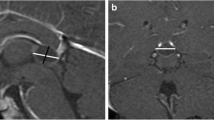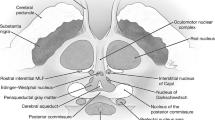Abstract
Background
Pineal cysts, both simple and complex, are commonly encountered in children. More cysts are being detected with MR technology; however, nearly all pineal cysts are benign and require no follow-up.
Objective
To discover the prevalence of pineal cysts in children at our institution who have undergone high-resolution 3-T MRI.
Materials and methods
We retrospectively reviewed 100 consecutive 3-T brain MRIs in children ages 1 month to 17 years (mean 6.8 ± 5.1 years). We evaluated 3-D volumetric T1-W imaging, axial T2-W imaging, axial T2-W FLAIR (fluid attenuated inversion recovery) and coronal STIR (short tau inversion recovery) sequences. Pineal parenchymal and cyst volumes were measured in three planes. Cysts were analyzed for the presence and degree of complexity.
Results
Pineal cysts were present in 57% of children, with a mean maximum linear dimension of 4.2 mm (range 1.5–16 mm). Of these cysts, 24.6% showed thin septations or fluid levels reflecting complexity. None of the cysts demonstrated complete T2/FLAIR signal suppression. No cyst wall thickening or nodularity was present. There was no significant difference between the ages of children with and without cysts. Cysts were more commonly encountered in girls than boys (67% vs. 52%; P = 0.043). There was a slight trend toward increasing pineal gland volume with age.
Conclusion
Pineal cysts are often present in children and can be incidentally detected by 3-T MRI. Characteristic-appearing pineal cysts in children are benign, incidental findings, for which follow-up is not required if there are no referable symptoms or excessive size.





Similar content being viewed by others
References
Al-Holou WN, Hugh JL, Muraszko KM et al (2009) Prevalence of pineal cysts in children and young adults. J Neurosurg Pediatr 4:230–236
Bumb JM, Brockmann MA, Groden C et al (2012) TrueFISP of the pediatric pineal gland. Clin Neuroradiol 22:69–77
Di Costanzo A, Tedeschi G, Di Salle F et al (1993) Pineal cysts: an incidental MRI finding? J Neurol Neurosurg Psychiatry 56:207–208
Lacroix-Boudhrioua VL, Linglart A, Ancel PY et al (2011) Pineal cysts in children. Insights Imaging 2:671–678
Zajac A, Skowrokek-Bala B, Wesolowska E et al (2010) The pineal cyst in children with different central nervous system diseases. Przegl Lek 67:1136–1139
Fleege MA, Miller GM, Fletcher GP et al (1994) Benign glial cysts of the pineal gland: unusual imaging characteristics with histologic correlation. AJNR Am J Neuroradiol 15:161–166
Engel U, Gottschalk S, Niehaus L et al (2000) Cystic lesions of the pineal region—MRI and pathology. Neuroradiology 42:399–402
Mandera M, Wieslaw M, Bierzynska-Macyszyn G et al (2003) Pineal cysts in childhood. Childs Nerv Syst 19:750–755
Fakhran S, Escott EJ (2008) Pineocytoma mimicking a pineal cyst on imaging: true diagnostic dilemma or a case of incomplete imaging? AJNR Am J Neuroradiol 29:159–163
Rosset A, Spadola L, Ratib O (2004) OsiriX: an open-source software for navigating in multidimensional DICOM images. J Digit Imaging 17:205–216
Silman RE, Leone RM, Hooper RJ et al (1979) Melatonin, the pineal gland and human puberty. Nature 282:301–303
Gillis FH, Nelson MD (2012) The developing human brain: Growth and adversities (clinics in developmental medicine), 1st edn. MacKeith Press, London, pp 36–38
Carr JL (1994) Cystic hydrops of the pineal gland. J Nerv Ment Dis 99:552–572
Al-Holou WN, Maher CO, Muraszkio KM et al (2010) The natural history of pineal cysts in children and young adults. Neurosurg Pediatr 5:162–166
Fain JS, Tomlinson FH, Scheithauer BW et al (1994) Symptomatic glial cysts of the pineal gland. J Neurosurg 80:454–460
Hasegawa A, Ohtsubo K, Mori W (1987) Pineal gland in old age; quantitative and qualitative morphological study of 168 human autopsy cases. Brain Res 409:343–349
Sun B, Wang D, Tang Y et al (2009) The pineal volume: a three-dimensional volumetric study in healthy young adults using 3.0 T MR data. Int J Dev Neurosci 27:655–660
Pu Y, Mahankali S, Hou J et al (2007) High prevalence of pineal cysts in healthy adults demonstrated by high-resolution, noncontrast brain MR imaging. AJNR Am J Neuroradiol 28:1706–1709
Pastel DA, Mamourian AC, Duhaime AC (2009) Internal structure in pineal cysts on high-resolution magnetic resonance imaging: not a sign of malignancy. J Neurosurg Pediatr 4:81–84
Cauley KA, Linnell GJ, Braff SP et al (2009) Serial follow-up MRI of indeterminate cystic lesions of the pineal region: experience at a rural tertiary care referral center. AJR Am J Roentgenol 193:533–537
Barboriak DP, Lee L, Provenzale JM (2000) Serial MR imaging of pineal cysts: implications for natural history and follow-up. AJR Am J Roentgenol 176:737–743
Hayashida Y, Hirai T, Korogi Y et al (2004) Pineal cystic germinoma with syncytiotrophoblastic giant cells mimicking MR imaging findings of a pineal cyst. AJNR Am J Neuroradiol 25:1538–1540
Kluczewska E, Giec-Lorenz A, Bazowski P et al (1999) Pineal cyst in MRI: clinical symptoms and analysis. Neurol Neurochir Pol 33:1033–1044
Engel U, Gottschalk S, Niehaus L et al (1994) Symptomatic glial cysts of the pineal gland. J Neurosurg 80:454–460
Wisoff JH, Epstein F (1992) Surgical management of symptomatic pineal cysts. J Neurosurg 77:896–900
Al-Holou WN, Terman SW, Kilburg C et al (2011) Prevalence and natural history of pineal cysts in adults. J Neurosurg 115:1106–1114
Mena H, Armonda RA, Ribas JL et al (1997) Nonneoplastic pineal cysts: a clinicopathologic study of twenty-one cases. Ann Diagn Pathol 1:11–18
Acknowledgments
This work was presented at the 98th Scientific Assembly and Annual Meeting of the Radiological Society of North America, Nov. 25-30, 2012.
Conflicts of interest
None.
Author information
Authors and Affiliations
Corresponding author
Rights and permissions
About this article
Cite this article
Whitehead, M.T., Oh, C.C. & Choudhri, A.F. Incidental pineal cysts in children who undergo 3-T MRI. Pediatr Radiol 43, 1577–1583 (2013). https://doi.org/10.1007/s00247-013-2742-x
Received:
Revised:
Accepted:
Published:
Issue Date:
DOI: https://doi.org/10.1007/s00247-013-2742-x




